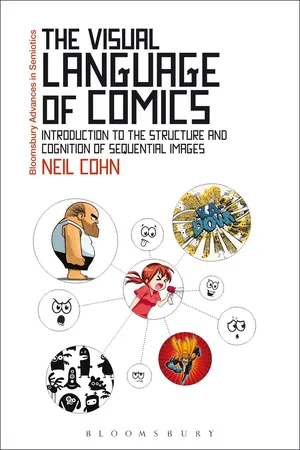
The Visual Language of Comics
Introduction to the Structure and Cognition of Sequential Images.
- 256 pages
- English
- PDF
- Available on iOS & Android
The Visual Language of Comics
Introduction to the Structure and Cognition of Sequential Images.
About this book
Drawings and sequential images are an integral part of human expression dating back at least as far as cave paintings, and in contemporary society appear most prominently in comics. Despite this fundamental part of human identity, little work has explored the comprehension and cognitive underpinnings of visual narratives-until now. This work presents a provocative theory: that drawings and sequential images are structured the same as language. Building on contemporary theories from linguistics and cognitive psychology, it argues that comics are written in a visual language of sequential images that combines with text. Like spoken and signed languages, visual narratives use a lexicon of systematic patterns stored in memory, strategies for combining these patterns into meaningful units, and a hierarchic grammar governing the combination of sequential images into coherent expressions. Filled with examples and illustrations, this book details each of these levels of structure, explains how cross-cultural differences arise in diverse visual languages of the world, and describes what the newest neuroscience research reveals about the brain's comprehension of visual narratives. From this emerges the foundation for a new line of research within the linguistic and cognitive sciences, raising intriguing questions about the connections between language and the diversity of humans' expressive behaviours in the mind and brain.
Frequently asked questions
- Essential is ideal for learners and professionals who enjoy exploring a wide range of subjects. Access the Essential Library with 800,000+ trusted titles and best-sellers across business, personal growth, and the humanities. Includes unlimited reading time and Standard Read Aloud voice.
- Complete: Perfect for advanced learners and researchers needing full, unrestricted access. Unlock 1.4M+ books across hundreds of subjects, including academic and specialized titles. The Complete Plan also includes advanced features like Premium Read Aloud and Research Assistant.
Please note we cannot support devices running on iOS 13 and Android 7 or earlier. Learn more about using the app.
Information
Table of contents
- FC
- Half Title
- ADVANCES IN SEMIOTICS
- Title
- Copyright
- Dedication
- Contents
- List of Figures
- Introduction
- 1 Introducing Visual Language
- SECTION 1 Structur e of visual language
- 2 The Visual Lexicon, Part 1: Visual Morphology
- 3 The Visual Lexicon, Part 2: Panels and Constructions
- 4 Visual Language Grammar: Narrative Structure
- Discourse and Film
- Conclusion
- 5 Navigation of External Compositional Structure
- 6 Cognition of Visual Language
- Narrative grammar
- Fluency
- SECTION 2 Visual language across the world
- Morphology
- Narrative grammar
- Languages versus dialects
- 8 Japanese Visual Language
- Influence in Japan and abroad
- 9 Central Australian Visual Language
- Cultural role
- Graphic structure
- Lexicon and morphology
- Narrative grammar
- Culture meets structure
- 10 The Principle of Equivalence
- Graphic references
- References
- Index